Itthi Chatnuntawech
Wave-Encoded Model-based Deep Learning for Highly Accelerated Imaging with Joint Reconstruction
Feb 06, 2022Abstract:Purpose: To propose a wave-encoded model-based deep learning (wave-MoDL) strategy for highly accelerated 3D imaging and joint multi-contrast image reconstruction, and further extend this to enable rapid quantitative imaging using an interleaved look-locker acquisition sequence with T2 preparation pulse (3D-QALAS). Method: Recently introduced MoDL technique successfully incorporates convolutional neural network (CNN)-based regularizers into physics-based parallel imaging reconstruction using a small number of network parameters. Wave-CAIPI is an emerging parallel imaging method that accelerates the imaging speed by employing sinusoidal gradients in the phase- and slice-encoding directions during the readout to take better advantage of 3D coil sensitivity profiles. In wave-MoDL, we propose to combine the wave-encoding strategy with unrolled network constraints to accelerate the acquisition speed while enforcing wave-encoded data consistency. We further extend wave-MoDL to reconstruct multi-contrast data with controlled aliasing in parallel imaging (CAIPI) sampling patterns to leverage similarity between multiple images to improve the reconstruction quality. Result: Wave-MoDL enables a 47-second MPRAGE acquisition at 1 mm resolution at 16-fold acceleration. For quantitative imaging, wave-MoDL permits a 2-minute acquisition for T1, T2, and proton density mapping at 1 mm resolution at 12-fold acceleration, from which contrast weighted images can be synthesized as well. Conclusion: Wave-MoDL allows rapid MR acquisition and high-fidelity image reconstruction and may facilitate clinical and neuroscientific applications by incorporating unrolled neural networks into wave-CAIPI reconstruction.
Nonlinear Dipole Inversion (NDI) enables Quantitative Susceptibility Mapping (QSM) without parameter tuning
Sep 30, 2019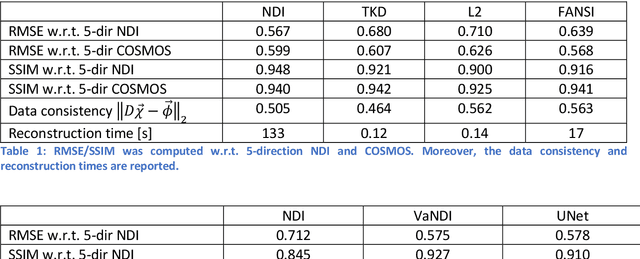

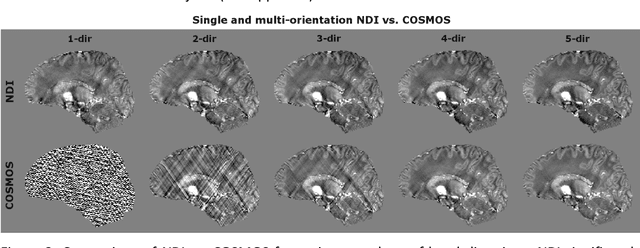
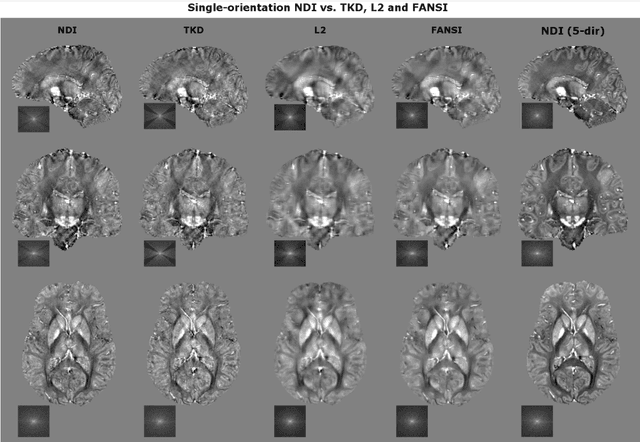
Abstract:We propose Nonlinear Dipole Inversion (NDI) for high-quality Quantitative Susceptibility Mapping (QSM) without regularization tuning, while matching the image quality of state-of-the-art reconstruction techniques. In addition to avoiding over-smoothing that these techniques often suffer from, we also obviate the need for parameter selection. NDI is flexible enough to allow for reconstruction from an arbitrary number of head orientations, and outperforms COSMOS even when using as few as 1-direction data. This is made possible by a nonlinear forward-model that uses the magnitude as an effective prior, for which we derived a simple gradient descent update rule. We synergistically combine this physics-model with a Variational Network (VN) to leverage the power of deep learning in the VaNDI algorithm. This technique adopts the simple gradient descent rule from NDI and learns the network parameters during training, hence requires no additional parameter tuning. Further, we evaluate NDI at 7T using highly accelerated Wave-CAIPI acquisitions at 0.5 mm isotropic resolution and demonstrate high-quality QSM from as few as 2-direction data.
Highly Accelerated Multishot EPI through Synergistic Combination of Machine Learning and Joint Reconstruction
Aug 08, 2018
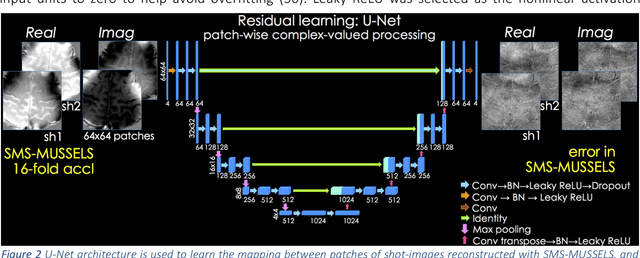
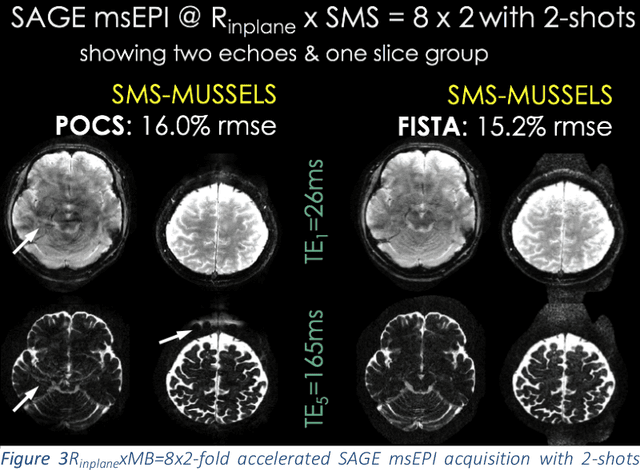
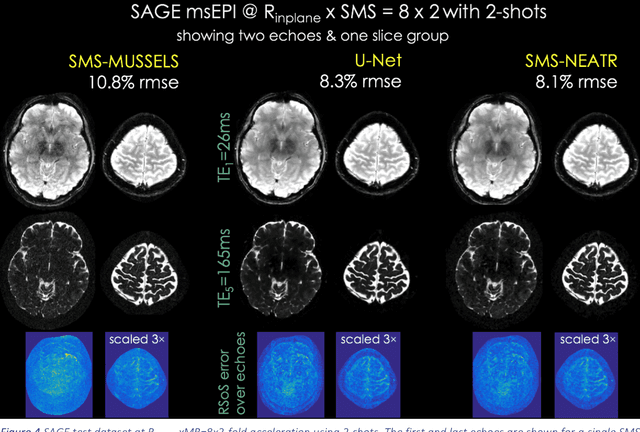
Abstract:Purpose: To introduce a combined machine learning (ML) and physics-based image reconstruction framework that enables navigator-free, highly accelerated multishot echo planar imaging (msEPI), and demonstrate its application in high-resolution structural imaging. Methods: Singleshot EPI is an efficient encoding technique, but does not lend itself well to high-resolution imaging due to severe distortion artifacts and blurring. While msEPI can mitigate these artifacts, high-quality msEPI has been elusive because of phase mismatch arising from shot-to-shot physiological variations which disrupt the combination of the multiple-shot data into a single image. We employ Deep Learning to obtain an interim magnitude-valued image with minimal artifacts, which permits estimation of image phase variations due to shot-to-shot physiological changes. These variations are then included in a Joint Virtual Coil Sensitivity Encoding (JVC-SENSE) reconstruction to utilize data from all shots and improve upon the ML solution. Results: Our combined ML + physics approach enabled R=8-fold acceleration from 2 EPI-shots while providing 1.8-fold error reduction compared to the MUSSELS, a state-of-the-art reconstruction technique, which is also used as an input to our ML network. Using 3 shots allowed us to push the acceleration to R=10-fold, where we obtained a 1.7-fold error reduction over MUSSELS. Conclusion: Combination of ML and JVC-SENSE enabled navigator-free msEPI at higher accelerations than previously possible while using fewer shots, with reduced vulnerability to poor generalizability and poor acceptance of end-to-end ML approaches.
Rice Classification Using Spatio-Spectral Deep Convolutional Neural Network
May 30, 2018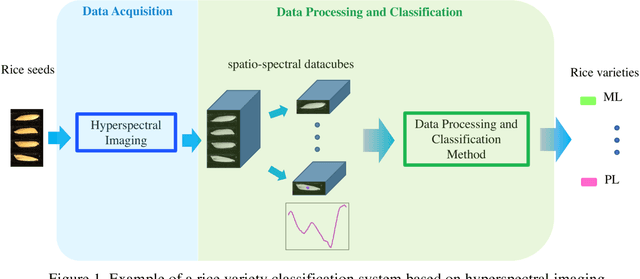
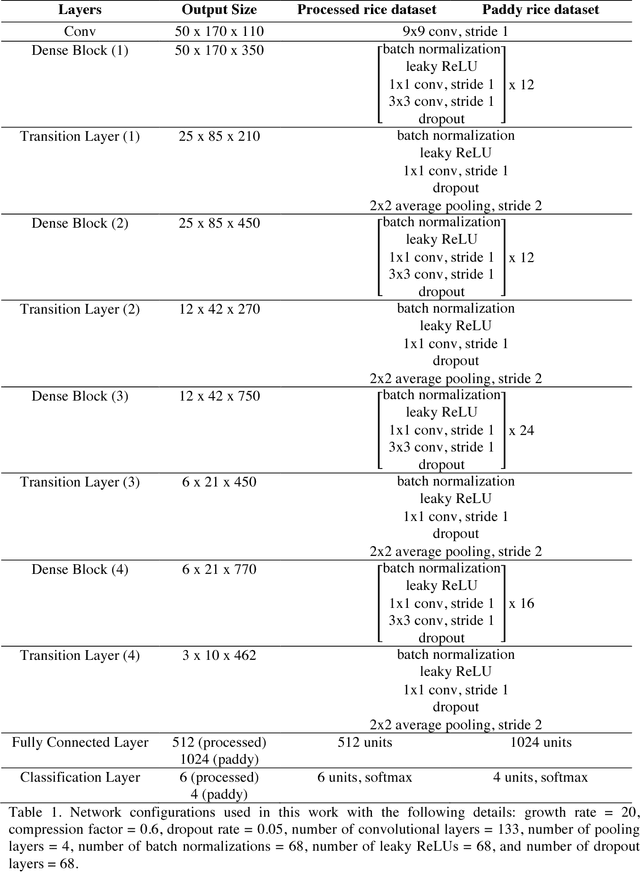
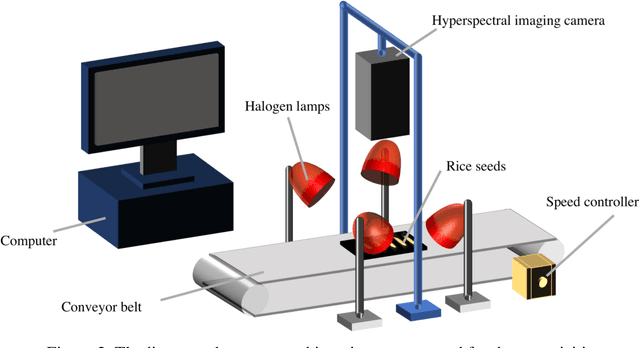

Abstract:Rice has been one of the staple foods that contribute significantly to human food supplies. Numerous rice varieties have been cultivated, imported, and exported worldwide. Different rice varieties could be mixed during rice production and trading. Rice impurities could damage the trust between rice importers and exporters, calling for the need to develop a rice variety inspection system. In this work, we develop a non-destructive rice variety classification system that benefits from the synergy between hyperspectral imaging and deep convolutional neural network (CNN). The proposed method uses a hyperspectral imaging system to simultaneously acquire complementary spatial and spectral information of rice seeds. The rice varieties are then determined from the acquired spatio-spectral data using a deep CNN. As opposed to several existing rice variety classification methods that require hand-engineered features, the proposed method automatically extracts features from the raw sensor data. As demonstrated using two types of rice datasets, the proposed method achieved up to 8% relative improvement in the classification accuracy compared to the commonly used classification methods based on support vector machines.
 Add to Chrome
Add to Chrome Add to Firefox
Add to Firefox Add to Edge
Add to Edge